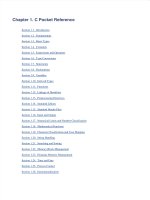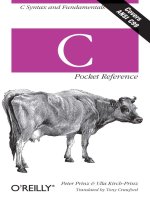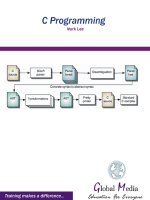IT training c pocket reference c syntax and fundamentals prinz kirch prinz 2002 11 30
Bạn đang xem bản rút gọn của tài liệu. Xem và tải ngay bản đầy đủ của tài liệu tại đây (1.35 MB, 142 trang )
C
Pocket Reference
Peter Prinz and Ulla Kirch-Prinz
Translated by Tony Crawford
Beijing • Cambridge • Farnham • Köln • Paris • Sebastopol • Taipei • Tokyo
C Pocket Reference
by Peter Prinz and Ulla Kirch-Prinz
Copyright © 2003 O’Reilly Media, Inc. All rights reserved.
Printed in the United States of America. This book was originally published
as C kurz & gut, Copyright © 2002 by O’Reilly Verlag GmbH & Co. KG.
Published by O’Reilly Media, Inc., 1005 Gravenstein Highway North,
Sebastopol, CA 95472.
O’Reilly Media, Inc. books may be purchased for educational,
business, or sales promotional use. Online editions are also available
for most titles (safari.oreilly.com). For more information, contact our
corporate/institutional sales department: (800) 998-9938 or
Editor:
Production Editor:
Cover Designer:
Interior Designer:
Jonathan Gennick
Jane Ellin
Pam Spremulli
David Futato
Printing History:
November 2002:
First Edition.
Nutshell Handbook, the Nutshell Handbook logo, and the O’Reilly
logo are registered trademarks of O’Reilly Media, Inc. The Pocket
Reference series designations, C Pocket Reference, the image of a cow,
and related trade dress are trademarks of O’Reilly Media, Inc. Many of
the designations used by manufacturers and sellers to distinguish their
products are claimed as trademarks. Where those designations appear
in this book, and O’Reilly Media, Inc. was aware of a trademark claim,
the designations have been printed in caps or initial caps.
While every precaution has been taken in the preparation of this book,
the publisher and authors assume no responsibility for errors or
omissions, or for damages resulting from the use of the information
contained herein.
0-596-00436-2
[C]
[6/06]
Contents
Introduction
1
Fundamentals
C Program Structure
Character Sets
Identifiers
Categories and Scope of Identifiers
2
3
4
6
7
Basic Types
Integer Types
Real and Complex Floating Types
The Type void
9
9
11
13
Constants
Integer Constants
Floating Constants
Character Constants and String Literals
14
14
16
16
Expressions and Operators
Arithmetic Operators
Assignment Operators
Relational Operators
Logical Operators
Bitwise Operators
Memory Accessing Operators
Other Operators
18
20
21
22
23
24
25
27
v
Type Conversions
Integer Promotion
Usual Arithmetic Conversions
Type Conversions in Assignments and Pointers
29
29
30
30
Statements
Block and Expression Statements
Jumps
Loops
Unconditional Jumps
31
32
33
35
37
Declarations
General Syntax and Examples
Complex Declarations
39
39
40
Variables
Storage Classes
Initialization
41
41
42
Derived Types
Enumeration Types
Structures, Unions, and Bit-Fields
Arrays
Pointers
Type Qualifiers and Type Definitions
43
43
45
49
52
55
Functions
Function Prototypes
Function Definitions
Function Calls
Functions with Variable Numbers of Arguments
57
58
59
61
62
Linkage of Identifiers
64
Preprocessing Directives
65
vi |
Contents
Standard Library
73
Standard Header Files
73
Input and Output
Error Handling for Input/Output Functions
General File Access Functions
File Input/Output Functions
74
76
76
79
Numerical Limits and Number Classification
Value Ranges of Integer Types
Range and Precision of Real Floating Types
Classification of Floating-Point Numbers
87
87
88
90
Mathematical Functions
Mathematical Functions for Integer Types
Mathematical Functions for Real Floating Types
Optimizing Runtime Efficiency
Mathematical Functions for Complex Floating Types
Type-Generic Macros
Error Handling for Mathematical Functions
The Floating-Point Environment
91
91
92
94
95
96
97
98
Character Classification and Case Mapping
101
String Handling
Conversion Between Strings and Numbers
Multibyte Character Conversion
103
105
107
Searching and Sorting
108
Memory Block Management
109
Dynamic Memory Management
110
Time and Date
111
Contents |
vii
Process Control
Communication with the Operating System
Signals
Non-Local Jumps
Error Handling for System Functions
113
113
114
115
116
Internationalization
116
Index
121
viii |
Contents
C Pocket Reference
Introduction
The programming language C was developed in the 1970s by
Dennis Ritchie at Bell Labs (Murray Hill, New Jersey) in the
process of implementing the Unix operating system on a
DEC PDP-11 computer. C has its origins in the typeless programming language BCPL (Basic Combined Programming
Language, developed by M. Richards) and in B (developed by
K. Thompson). In 1978, Brian Kernighan and Dennis Ritchie
produced the first publicly available description of C, now
known as the K&R standard.
C is a highly portable language oriented towards the architecture of today’s computers. The actual language itself is relatively small and contains few hardware-specific elements. It
includes no input/output statements or memory management techniques, for example. Functions to address these
tasks are available in the extensive C standard library.
C’s design has significant advantages:
• Source code is highly portable
• Machine code is efficient
• C compilers are available for all current systems
The first part of this pocket reference describes the C language, and the second part is devoted to the C standard
library. The description of C is based on the ANSI X3.159
standard. This standard corresponds to the international
1
standard ISO/IEC 9899, which was adopted by the International Organization for Standardization in 1990, then
amended in 1995 and 1999. The ISO/IEC 9899 standard can
be ordered from the ANSI web site; see i.
org/.
The 1995 standard is supported by all common C compilers
today. The new extensions defined in the 1999 release (called
“ANSI C99” for short) are not yet implemented in many C
compilers, and are therefore specially labeled in this book.
New types, functions, and macros introduced in ANSI C99
are indicated by an asterisk in parentheses (*).
Font Conventions
The following typographic conventions are used in this
book:
Italic
Used to introduce new terms, and to indicate filenames.
Constant width
Used for C program code as well as for functions and
directives.
Constant width italic
Indicates replaceable items within code syntax.
Constant width bold
Used to highlight code passages for special attention.
Fundamentals
A C program consists of individual building blocks called
functions, which can invoke one another. Each function performs a certain task. Ready-made functions are available in
the standard library; other functions are written by the programmer as necessary. A special function name is main():
this designates the first function invoked when a program
starts. All other functions are subroutines.
2 |
C Pocket Reference
C Program Structure
Figure 1 illustrates the structure of a C program. The program shown consists of the functions main() and showPage(),
and prints the beginning of a text file to be specified on the
command line when the program is started.
/* Head.c: This program outputs the beginning of a
* text file to the standard output.
* Usage : Head <filename>
#include <stdio.h>
#define LINES
Preprocessor directives
22
void showPage( FILE * );
*
* Comments
*/
// prototype
Funtion main()
int main( int argc, char **argv )
{
FILE *fp; int exit_code = 0;
if ( argc != 2 )
{
fprintf( stderr, "Usage: Head <filename>\n" );
exit_code = 1;
}
else if ( ( fp = fopen( argv[1], "r" )) == NULL )
{
fprintf( stderr, "Error opening file!\n" );
exit_code = 2;
}
else
{
showPage( fp );
fclose( fp );
}
return exit_code;
}
void showPage( FILE *fp )
// Output a screen page Other functions
{
int count = 0;
char line[81];
while ( count < LINES && fgets( line, 81, fp ) != NULL )
{
fputs( line, stdout );
++count;
}
}
Figure 1. A C program
The statements that make up the functions, together with the
necessary declarations and preprocessing directives, form the
source code of a C program. For small programs, the source
code is written in a single source file. Larger C programs
Fundamentals |
3
consist of several source files, which can be edited and compiled separately. Each such source file contains functions
that belong to a logical unit, such as functions for output to a
terminal, for example. Information that is needed in several
source files, such as declarations, is placed in header files.
These can then be included in each source file via the
#include directive.
Source files have names ending in .c; header files have names
ending in .h. A source file together with the header files
included in it is called a translation unit.
There is no prescribed order in which functions must be
defined. The function showPage() in Figure 1 could also be
placed before the function main(). A function cannot be
defined within another function, however.
The compiler processes each source file in sequence and
decomposes its contents into tokens, such as function names
and operators. Tokens can be separated by one or more
whitespace characters, such as space, tab, or newline characters. Thus only the order of tokens in the file matters. The
layout of the source code—line breaks and indentation, for
example—is unimportant. The preprocessing directives are an
exception to this rule, however. These directives are commands to be executed by the preprocessor before the actual
program is compiled, and each one occupies a line to itself,
beginning with a hash mark (#).
Comments are any strings enclosed either between /* and */,
or between // and the end of the line. In the preliminary
phases of translation, before any object code is generated,
each comment is replaced by one space. Then the preprocessing directives are executed.
Character Sets
ANSI C defines two character sets. The first is the source
character set, which is the set of characters that may be used
4 |
C Pocket Reference
in a source file. The second is the execution character set,
which consists of all the characters that are interpreted during the execution of the program, such as the characters in a
string constant.
Each of these character sets contains a basic character set,
which includes the following:
• The 52 upper- and lower-case letters of the Latin alphabet:
A B C D E F G H I J K L M N O P Q R S T U V W X Y Z
a b c d e f g h i j k l m n o p q r s t u v w x y z
• The ten decimal digits (where the value of each character
after 0 is one greater than the previous digit):
0
1
2
3
4
5
6
7
8
9
• The following 29 graphic characters:
!
<
"
=
#
>
%
?
&
[
'
\
(
]
)
^
*
_
+
{
,
|
–
}
.
~
/
:
;
• The five whitespace characters:
space, horizontal tab, vertical tab, newline, form feed
In addition, the basic execution character set contains the
following:
• The null character \0, which terminates a character string
• The control characters represented by simple escape
sequences, shown in Table 1, for controlling output
devices such as terminals or printers
Table 1. The standard escape sequences
Escape
sequence
Action on
display device
Escape
sequence
Action on
display device
\a
Alert (beep)
\'
The character '
\b
Backspace
\"
The character "
\f
Form feed
\?
The character ?
\n
Newline
\\
The character \
\r
Carriage return
\o \oo \ooo
(o = octal digit)
The character with
this octal code
Fundamentals |
5
Table 1. The standard escape sequences (continued)
Escape
sequence
Action on
display device
Escape
sequence
Action on
display device
\t
Horizontal tab
\v
Vertical tab
\xh..
(h..= string of
The character with
this hexadecimal
code
hex digits)
Any other characters, depending on the given compiler, can
be used in comments, strings, and character constants. These
may include the dollar sign or diacriticals, for example. However, the use of such characters may affect portability.
The set of all usable characters is called the extended character set, which is always a superset of the basic character set.
Certain languages use characters that require more than one
byte. These multibyte characters may be included in the
extended character set. Furthermore, ANSI C99 provides the
integer type wchar_t (wide character type), which is large
enough to represent any character in the extended character
set. The modern Unicode character encoding is often used,
which extends the standard ASCII code to represent some
35,000 characters from 24 countries.
C99 also introduces trigraph sequences. These sequences,
shown in Table 2, can be used to input graphic characters
that are not available on all keyboards. The sequence ??!,
for example, can be entered to represent the “pipe” character |.
Table 2. The trigraph sequences
Trigraph
??=
??(
??/
??)
??'
??<
??!
??>
??-
Meaning
#
[
\
]
^
{
|
}
~
Identifiers
Identifiers are names of variables, functions, macros, types,
etc. Identifiers are subject to the following formative rules:
6 |
C Pocket Reference
• An identifier consists of a sequence of letters (A to Z, a to
z), digits (0 to 9), and underscores (_).
• The first character of an identifier must not be a digit.
• Identifiers are case-sensitive.
• There is no restriction on the length of an identifier.
However, only the first 31 characters are generally significant.
Keywords are reserved and must not be used as identifiers.
Following is a list of keywords:
auto
enum
restrict(*)
unsigned
break
extern
return
void
case
float
short
volatile
char
for
signed
while
const
goto
sizeof
_Bool(*)
continue
if
static
_Complex(*)
default
inline(*)
struct
_Imaginary(*)
do
int
switch
double
long
typedef
else
register
union
External names—that is, identifiers of externally linked functions and variables—may be subject to other restrictions,
depending on the linker: in portable C programs, external
names should be chosen so that only the first eight characters are significant, even if the linker is not case-sensitive.
Some examples of identifiers are:
Valid: a, DM, dm, FLOAT, _var1, topOfWindow
Invalid: do, 586_cpu, zähler, nl-flag, US_$
Categories and Scope of Identifiers
Each identifier belongs to exactly one of the following four
categories:
Fundamentals |
7
• Label names
• The tags of structures, unions, and enumerations. These
are identifiers that follow one of the keywords struct,
union, or enum (see “Derived Types”).
• Names of structure or union members. Each structure or
union type has a separate name space for its members.
• All other identifiers, called ordinary identifiers.
Identifiers of different categories may be identical. For example, a label name may also be used as a function name. Such
re-use occurs most often with structures: the same string can
be used to identify a structure type, one of its members, and
a variable; for example:
struct person {char *person; /*...*/} person;
The same names can also be used for members of different
structures.
Each identifier in the source code has a scope. The scope is
that portion of the program in which the identifier can be
used. The four possible scopes are:
Function prototype
Identifiers in the list of parameter declarations of a function prototype (not a function definition) have function
prototype scope. Because these identifiers have no meaning outside the prototype itself, they are little more than
comments.
Function
Only label names have function scope. Their use is limited to the function block in which the label is defined.
Label names must also be unique within the function.
The goto statement causes a jump to a labelled statement within the same function.
Block
Identifiers declared in a block that are not labels have
block scope. The parameters in a function definition also
have block scope. Block scope begins with the
8 |
C Pocket Reference
declaration of the identifier and ends with the closing
brace (}) of the block.
File
Identifiers declared outside all blocks and parameter lists
have file scope. File scope begins with the declaration of
the identifier and extends to the end of the source file.
An identifier that is not a label name is not necessarily visible
throughout its scope. If an identifier with the same category
as an existing identifier is declared in a nested block, for
example, the outer declaration is temporarily hidden. The
outer declaration becomes visible again when the scope of
the inner declaration ends.
Basic Types
The type of a variable determines how much space it occupies in storage and how the bit pattern stored is interpreted.
Similarly, the type of a function determines how its return
value is to be interpreted.
Types can be either predefined or derived. The predefined
types in C are the basic types and the type void. The basic
types consist of the integer types and the floating types.
Integer Types
There are five signed integer types: signed char, short int
(or short), int, long int (or long), and long long int(*) (or
long long(*)). For each of these types there is a corresponding unsigned integer type with the same storage size. The
unsigned type is designated by the prefix unsigned in the type
specifier, as in unsigned int.
The types char, signed char, and unsigned char are formally
different. Depending on the compiler settings, however, char
is equivalent either to signed char or to unsigned char. The
prefix signed has no meaning for the types short, int, long,
Basic Types
|
9
and long long(*), however, since they are always considered
to be signed. Thus short and signed short specify the same
type.
The storage size of the integer types is not defined; however,
their width is ranked in the following order: char <= short
<= int <= long <= long long(*). Furthermore, the size of
type short is at least 2 bytes, long at least 4 bytes, and long
long at least 8 bytes. Their value ranges for a given implementation are found in the header file limits.h.
ANSI C99 also introduces the type _Bool to represent Boolean values. The Boolean value true is represented by 1 and
false by 0. If the header file stdbool.h has been included,
then bool can be used as a synonym for _Bool and the macros true and false for the integer constants 1 and 0. Table 3
shows the standard integer types together with some typical
value ranges.
Table 3. Standard integer types with storage sizes and value ranges
Type
Storage size Value range (decimal)
_Bool
1 byte
0 and 1
char
1 byte
-128 to 127 or 0 to 255
unsigned char
1 byte
0 to 255
signed char
1 byte
-128 to 127
int
2 or 4 bytes
-32,768 to 32,767 or
-2,147,483,648 to 2,147,483,647
unsigned int
2 or 4 bytes
0 to 65,535 or
0 to 4,294,967,295
short
2 bytes
-32,768 to 32,767
unsigned short
2 bytes
0 to 65,535
long
4 bytes
-2,147,483,648 to 2,147,483,647
unsigned long
4 bytes
0 to 4,294,967,295
long long(*)
8 bytes
-9,223,372,036,854,775,808 to
9,223,372,036,854,775,807
unsigned long long(*)
8 bytes
0 to 18,446,744,073,709,551,615
10 |
C Pocket Reference
ANSI C99 introduced the header file stdint.h(*), which
defines integer types with specific widths (see Table 4). The
width N of an integer type is the number of bits used to represent values of that type, including the sign bit. (Generally,
N = 8, 16, 32, or 64.)
Table 4. Integer types with defined width
Type
Meaning
intN_t
Width is exactly N bits
int_leastN_t
Width is at least N bits
int_fastN_t
The fastest type with width of at least N bits
intmax_t
The widest integer type implemented
intptr_t
Wide enough to store the value of a pointer
For example, int16_t is an integer type that is exactly 16 bits
wide, and int_fast32_t is the fastest integer type that is 32 or
more bits wide. These types must be defined for the widths
N = 8, 16, 32, and 64. Other widths, such as int24_t, are
optional. For example:
int16_t val = -10;
// integer variable
// width: exactly 16 bits
For each of the signed types described above, there is also an
unsigned type with the prefix u. uintmax_t, for example, represents the implementation’s widest unsigned integer type.
Real and Complex Floating Types
Three types are defined to represent non-integer real numbers: float, double, and long double. These three types are
called the real floating types.
The storage size and the internal representation of these
types are not specified in the C standard, and may vary from
one compiler to another. Most compilers follow the IEEE
754-1985 standard for binary floating-point arithmetic, however. Table 5 is also based on the IEEE representation.
Basic Types
|
11
Table 5. Real floating types
Type
Storage size
Value range
(decimal, unsigned)
Precision (decimal)
float
4 bytes
1.2E-38 to 3.4E+38
6 decimal places
double
8 bytes
2.3E-308 to 1.7E+308
15 decimal places
long double
10 bytes
3.4E-4932 to 1.1E+4932
19 decimal places
The header file float.h defines symbolic constants that
describe all aspects of the given representation (see “Numerical Limits and Number Classification”).
Internal representation of a real floating-point
number
The representation of a floating-point number x is always
composed of a sign s, a mantissa m, and an exponent exp to
base 2:
x = s * m * 2exp, where 1.0 <= m < 2
or
m = 0
The precision of a floating type is determined by the number
of bits used to store the mantissa. The value range is determined by the number of bits used for the exponent.
Figure 2 shows the storage format for the float type (32-bit)
in IEEE representation.
S
Bit position:
31
Exponent
30
Mantissa
23 22
0
Figure 2. IEEE storage format for the 32-bit float type
The sign bit S has the value 1 for negative numbers and 0 for
other numbers. Because in binary the first bit of the mantissa
is always 1, it is not represented. The exponent is stored with
a bias added, which is 127 for the float type.
For example, the number –2.5 = –1 * 1.25 * 21 is stored as:
S = 1, Exponent = 1+127 = 128, Mantissa = 0.25
12 |
C Pocket Reference
Complex floating types
ANSI C99 introduces special floating types to represent the
complex numbers and the pure imaginary numbers. Every
complex number z can be represented in Cartesian coordinates as follows:
z = x + i*y
where x and y are real numbers and i is the imaginary unit
-1 . The real numbers x and y represent respectively the real
part and the imaginary part of z.
Complex numbers can also be represented in polar coordinates:
z = r * (cos(theta) + i * sin(theta))
The angle theta is called the argument and the number r is
the magnitude or absolute value of z.
In C, a complex number is represented as a pair of real and
imaginary parts, each of which has type float, double, or
long double. The corresponding complex floating types are
float _Complex, double _Complex, and long double _Complex.
In addition, the pure imaginary numbers—i.e., the complex
numbers z = i*y where y is a real number—can also be represented by the types float _Imaginary, double _Imaginary,
and long double _Imaginary.
Together, the real and the complex floating types make up
the floating types.
The Type void
The type specifier void indicates that no value is available. It
is used in three kinds of situations:
Expressions of type void
There are two uses for void expressions. First, functions
that do not return a value are declared as void. For
example:
void exit (int status);
Basic Types
|
13
Second, the cast construction (void)expression can be
used to explicitly discard the value of an expression. For
example:
(void)printf("An example.");
Prototypes of functions that have no parameters
For example:
int rand(void);
Pointers to void
The type void * (pronounced “pointer to void”) represents the address of an object, but not the object’s type.
Such “typeless” pointers are mainly used in functions
that can be called with pointers to different types as
parameters. For example:
void *memcpy(void *dest, void *source, size_t count);
Constants
Every constant is either an integer constant, a floating constant, a character constant, or a string literal. There are also
enumeration constants, which are described in “Enumeration
Types.” Every constant has a type that is determined by its
value and its notation.
Integer Constants
Integer constants can be represented as ordinary decimal
numbers, octal numbers, or hexadecimal numbers:
• A decimal constant (base 10) begins with a digit that is
not 0; for example: 1024
• An octal constant (base 8) begins with a 0; for example:
012
• A hexadecimal constant (base 16) begins with the two
characters 0x or 0X; for example: 0x7f, 0X7f, 0x7F,
0X7F. The hexadecimal digits A to F are not casesensitive.
14 |
C Pocket Reference
The type of an integer constant, if not explicitly specified, is
the first type in the appropriate hierarchy that can represent
its value.
For decimal constants, the hierarchy of types is:
int, long, unsigned long, long long(*).
For octal or hexadecimal constants, the hierarchy of types is:
int, unsigned int, long, unsigned long, long long(*),
unsigned long long(*).
Thus, integer constants normally have type int. The type can
also be explicitly specified by one of the suffixes L or l (for
long), LL(*) or ll(*) (for long long(*)), and/or U or u (for
unsigned). Table 6 provides some examples.
Table 6. Examples of integer constants
Decimal
Octal
Hexadecimal
Type
15
017
0xf
int
32767
077777
0x7FFF
int
10U
012U
0xAU
unsigned int
32768U
0100000U
0x8000u
unsigned int
16L
020L
0x10L
long
27UL
033ul
0x1BUL
unsigned long
The macros in Table 7 are defined to represent constants of
an integer type with a given maximum or minimum width N
(e.g., = 8, 16, 32, 64). Each of these macros takes a constant
integer as its argument and is replaced by the same value
with the appropriate type.
Table 7. Macros for integer constants of minimum or maximum width
Macro
Return type
INTMAX_C()
intmax_t
UINTMAX_C()
uintmax_t
INTN_C()
int_leastN_t
UINTN_C()
uint_leastN_t
Constants
|
15
Floating Constants
A floating constant is represented as a sequence of decimal
digits with one decimal point, or an exponent notation.
Some examples are:
41.9
5.67E-3
// The number
5.67*10-3
E can also be written as e. The letter P or p is used to represent a floating constant with an exponent to base 2 (ANSI
C99); for example:
2.7P+6
// The number
2.7*26
The decimal point or the notation of an exponent using E, e,
P(*), or p(*) is necessary to distinguish a floating constant
from an integer constant.
Unless otherwise specified, a floating constant has type
double. The suffix F or f assigns the constant the type float;
the suffix L or l assigns it the type long double. Thus the
constants in the previous examples have type double, 12.34F
has type float, and 12.34L has type long double.
Each of the following constants has type double. All the constants in each row represent the same value:
5.19
0.519E1
0.0519e+2
519E-2
12.
12.0
.12E2
12e0
370000.0
37e+4
3.7E+5
0.37e6
0.000004
4E-6
0.4e-5
.4E-5
Character Constants and String Literals
A character constant consists of one or more characters
enclosed in single quotes. Some examples are:
'0'
'A'
'ab'
Character constants have type int. The value of a character
constant that contains one character is the numerical value of
16 |
C Pocket Reference
the representation of the character. For example, in the
ASCII code, the character constant '0' has the value 48, and
the constant 'A' has the value 65.
The value of a character constant that contains more than
one character is dependent on the given implementation. To
ensure portability, character constants with more than one
character should be avoided.
Escape sequences such as '\n' may be used in character constants. The characters ' and \ can also be represented this way.
The prefix L can be used to give a character constant the type
wchar_t; for example:
L'A'
L'\x123'
A string literal consists of a sequence of characters and
escape sequences enclosed in double quotation marks; for
example:
"I am a string!\n"
A string literal is stored internally as an array of char (see
“Derived Types”) with the string terminator '\0'. It is therefore one byte longer than the specified character sequence.
The empty string occupies exactly one byte. A string literal is
also called a string constant, although the memory it occupies may be modified.
The string literal "Hello!", for example, is stored as a char
array, as shown in Figure 3.
Stored as array of char
'H'
'e'
'l'
'l'
'o'
'!'
' \0 '
Figure 3. A string literal stored as a char array
String literals that are separated only by whitespace are concatenated into one string. For example:
"hello" " world!" is equivalent to "hello world!".
Constants
|
17









